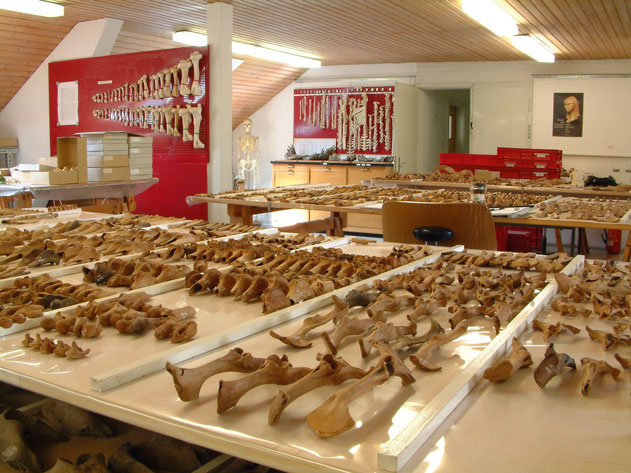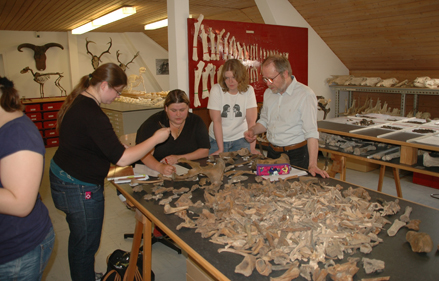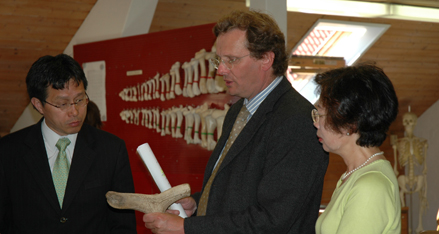The History of archaeozoology in Schleswig
The scientific analysis of animal remains from archaeological contexts has a long tradition at the Christian-Albrechts-Universität in Kiel and the closely-linked Archäologisches Landesmuseum in Schleswig. To date, more than 300 publications have emerged from the jointly founded Archäologisch-Zoologische Arbeitsgemeinschaft (AZA) (Archaeological-Zoological Working Group), which was established in the 1960s. Over the years, within the framework of this co-operation, several dozen students, in the fields of zoology, prehistory or early history, have produced their dissertations here.

The Archaeological-Zoological Work Group was founded in 1967 by staff of the Institut für Haustierkunde (today part of the Institute of Zoology) in Kiel and the Archäologisches Landesmuseum in Schleswig, as an interdisciplinary research institution under the Christian-Albrechts-Universität in Kiel. Since then it has been run jointly by both institutions. Zoological investigations of animal bones had already a long tradition at the Institute in Kiel. Initially, the focus was on anatomical-morphological studies aimed at gaining insights into the historical transition of wild animal species to domestic forms and, in this way, clarifying questions of descent and origin. Aspects of the regional fauna history were also investigated. During the 1960s, awareness grew of the fact that animal remains, i.e. bones, are also able to provide answers to archaeological questions. In particular, they can contribute to clarification of economic aspects of the past and the history of nutrition. The range of subjects extends from husbandry and breeding objectives relative to domestic animals, through evidence of slaughtering age and trade in animals for slaughter to the use of bone, antler and horn as raw materials in tool production.

As new extensive excavations were resumed in 1966 at Haithabu, the analysis of animal bones was, from the outset, destined for particular significance as an important zoological and archaeological source. Through the joint efforts of Prof. Dr Dr hon. Wolf Herre, the former director of the Institute in Kiel, and the then head of the archaeological excavations, Prof. Dr Kurt Schietzel, a plan was developed to relocate the archaeozoological work to Schleswig as an interdisciplinary task. Here, close at hand in the grounds of the Schleswig-Holsteinisches Landesmuseum at Gottorf Castle, the large premises necessary for working with the extensive find materials were available. The Institut für Haustierkunde contributed the comparative osteological collection of recent skeletons, which is of vital importance for the identification of sub-fossil animal bone remains, to the newly-established AZA. With the establishment of the AZA, a basis was also secured at this location for the scientific investigation of future archaeozoological assemblages, beyond the analysis of the finds from Haithabu.

During the first decades of the AZA, investigations of the animal bones recovered from Haithabu were the central research interest. Later, the finds from the historic city excavations of Schleswig and Lübeck, the Slavic castle of Starigard (Oldenburg), the Early Medieval terp (i.e. dwelling mound) of Elisenhof at Eiderstedt and also the analysis of Stone Age bone assemblages from Schleswig-Holstein constituted major research objects. In 2008, Prof. Dr Claus von Carnap-Bornheim succeeded in establishing the AZA as a laboratory within the department ‘Archäozoologie und Geschichte der Fauna’ (Archaeozoology and Faunal History) as a permanent part of the ZBSA. Today, the direction of the AZA’s research is due not least to this incorporation within the considerably more internationally-oriented ZBSA.
Further to its scientific activities, the AZA has also always served to educate students in the specific questions, problems and methods of archaeozoological research. This takes place, for example, via courses at the University in Kiel and internships in the laboratory in Schleswig.

The present scientific director of the AZA, Dr Ulrich Schmölcke, succeeds Dr Hans Reichstein (1967-1995) and Prof. Dr Dirk Heinrich (1974-2008), who both worked for many years at the AZA. They were, and are, in a position to build on the excellent efforts of former and present colleagues Rolf Rohde (1967-1978), Hans-Jörg Frisch (1971-1977), Wolfgang Lage (since 1998) and, in Kiel, Renate Lücht (since 1976), without whom several scientific studies and the supervision of the numerous students would not had been possible at the level actually achieved.